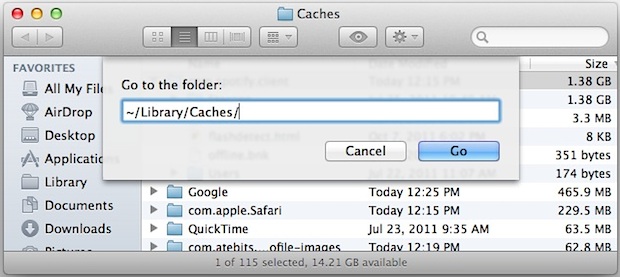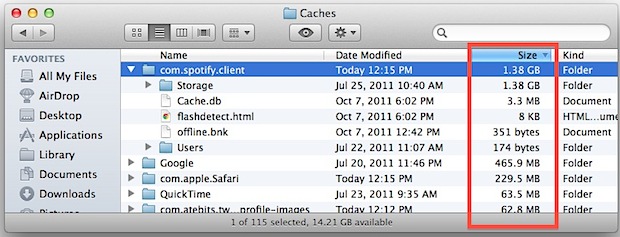Delete User Caches in Mac OS X

The user caches folder sits in ~/Library/ and contains cache files from nearly all applications that are actively used in Mac OS X. While most apps maintain their caches reasonably well and don’t let things get out of control, some aren’t so good at it, and some apps leave behind rather large folders that serve no purpose if you no longer use the application.
Accessing & Deleting User Cache Files in Mac OS X
- From the Mac OS X Desktop, hit Command+Shift+G to bring up “Go To Folder”
- Type ~/Library/Caches/
- If you want to delete ALL caches, remove everything in this folder – this is generally not recommended
- If you want to delete specific app caches, search for the app name and remove it manually
- You can select any folder and just hit Command+Delete to send the directory to the trash, otherwise drag it manually
You’ll notice some apps caches are named by “com.AppName.client” format, so don’t expect everything to appear as “AppName” in the directory.
Selectively Removing App Caches to Recover Disk Space
Removing app caches can also help to to recover disk space for apps that are no longer in use. For example, I haven’t used Spotify in several months, but the applications caches stored in com.spotify.client are taking up 1.38GB of disk space. Here’s how to find large app caches that are no longer used:
- From the Caches folder, go to the View menu and pull down to “Show View Options” (or hit Command+J)
- Click the checkbox next to “Calculate all sizes” near the bottom of the options, then close View Options
- View the folder in list view, and then click on “Size” to sort by the total size of each folders contents
- Delete offenders that are no longer in use

In some situations, even when you uninstall an app, not all traces of the application are removed, and manually removing the cache may be helpful or necessary to get rid of traces left around.
Other than taking up space, deleting specific app caches can sometimes resolve strange behavioral issues with certain applications.


OMG. I was looking at double digit free space and when I opened Storage it was mostly yellow. I tried to clean up Downloads, but what really got my 700+gigs of free space was going into ~/library/cache by hitting shift/command/g and knocking out things that looked suspicious. Even Quicktime Player or GoogleEarth function fine without those cache files. Everything looked the same after I emptied the trash, but when I hit restart I was greeted with a cleaner, meaner machine. Thanks so much. I hope this helps others too.
osx 10.9.5
on both my macbook pro and imac
every few weeks primary disk running low on storage.. and I cannot find what is eating the space.
my user folder is about 40 gigs. 200 gigs are ‘missing’
[…] continue to grow, and generally they aren’t cleared out until the app is quit. You can also delete the cache files manually, but it’s much easier to just relaunch your apps and have the OS clear it for you. It’s […]
Thanks for the tip. Managed to reclaim 50Gb of out dated Virtual Box VM’s. Useful software.
OnyX don’t do anything in One Click, even is a good app, You must know what you do, and many things checks before run…
Be aware that .plist files are sometimes also stored in ~/Library/Caches/ (Usually they are in ~/Library/Preferences/)
Deleting .plist files will cause you to lose custom setting you established in an Application’s Preferences.
On the other hand, deleting the .Plist file(s) for an app is something to try if an app is acting weird.
ONYX, MainMenu do the job in 1 clic also….why brainstorming when you can do an 1 clic ???
Spotify is eating up 4GB of my disk space, Steam and Blizzard takes up plenty too!
Based on that, I would bet some of the cached contents are partially completed downloads and updates.
If you are not seeing the size of the folders from the Finder “View” menu select “Show View Options” (or just press Command-J) and check the box for “Calculate all sizes”.
You can also get CCleaner (http://piriform.com/mac) to do the application flie cleaning and then some for you.